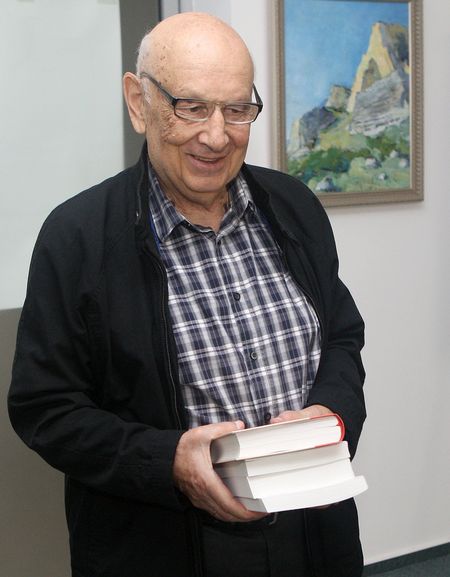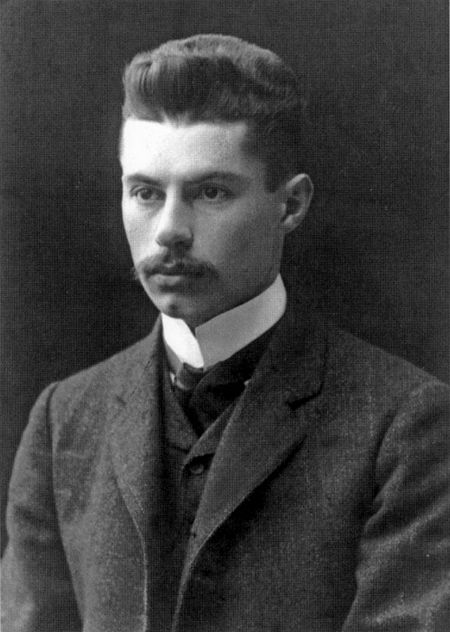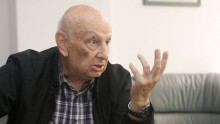In the first part of his interview (Issue № 59, October 5, 2017), Professor Yurii TERESHCHENKO, a well-known historian, Doctor of Sciences (History), one of the contributors to the Den Library’s new book The Crown, or Heritage of the Rus’ Kingdom, discusses the rivalry of the populist and monarchic world-views in the Ukrainian political tradition, analyzes the role of constitutional monarchy in today’s world, and tells his own history of reading Viacheslav Lypynsky’s works. This part deals with the origin of Kyivan princes’ royal dignity, the social basis of a hypothetical monarchic project in this country today, and the reason why, describing the prospects of Ukraine’s liberation, Taras Shevchenko turns to the heritage of George Washington rather than to the ideals of the French Revolution.
“EUROPEAN CHRONICLES ALWAYS CALLED THE RULERS OF RUS’ AS KINGS”
Mr. Tereshchenko, one of the key points in your article for The Crown, or Heritage of the Rus’ Kingdom is the statement that the Kyivan state of the Volodymyr and Yaroslav era had an internationally recognized status of kingdom. It seems to me that this fact radically changes the view of our history. In particular, this also changes the attitude to the coronation of Danylo, which looks now as an event that quite fits in with the logic of history, not as an extraordinary occurrence.
“Exactly. This fact confirms that the monarchic idea has deep roots in Ukrainian history.
“Our neighbors, particularly Bulgaria, which had the status of a principality in the European world after adopting Christianity, also struggled for a higher title of the head of state and for monarchic dignity. The claims of Bulgarian rulers to the title of tsar (basileus) encountered stiff resistance on the part of the Byzantine Empire. To achieve its goal, Bulgaria had to mount a serious political campaign and turn to German emperors and nobility for support.
“Poland also saw an extremely difficult process of establishing a kingdom. Polish princes held several coronations, but German emperors did not recognize them as legitimate and forced Polish rulers to withdraw their claims to the royal crown. It was not until the early 14th century, when Wladyslaw the Elbow-high was crowned, that Poland became a kingdom.
“At the same time, some proven facts show that Kyivan Prince Volodymyr was once recognized as a ruler vested with a monarchic title. What attracts our attention is, among other things, rather frequent exchanges of envoys between Rome and Kyiv after 988 and especially in 1000, when the envoy of Pope Sylvester II arrived in the capital of Rus’ with a retinue that also included representatives of other countries. This meant that, according to a papal tradition, they performed the function of coronation witnesses, which they had done in Hungary shortly before. Incidentally, the oriental title of ‘khagan,’ equal to that of emperor, was also applied to Volodymyr and Yaroslav. This is the way Ilarion, the first Ukrainian on the Kyivan metropolitan throne, addressed them, which went off the limits of Byzantine discourse. But, as Christianity was established, it was no longer possible to use an oriental monarchic title. A number of European chroniclers apply a kingly, not princely, nomenclature to Volodymyr. For example, German chronicler Thietmar of Merseburg, a contemporary of the Kyivan ruler, titled him as King Volodymyr of Rus’ (rex Ruscorum Wlodemirus), while he applied the title of duke (dux) to Polish Prince Boleslaw the Brave. Thietmar also applied a kingly nomenclature to Yaroslav the Wise. In addition to the two Kyivan rules, he used the title of king (rex) in respect of English and Scandinavian monarchs and only that of duke (dux) in respect of Stephen I of Hungary, Polish, Czech, and Polabian princes. A coin of those times depicts Volodymyr sitting on the throne with a royal crown on the head. All this allowed Mykhailo Hrushevsky to say that Volodymyr’s coronation ‘still remains hypothetical, albeit very plausible.’
“After the death of Yaroslav, the royal honor of his son Iziaslav was confirmed by Pope Gregory VII. Some time later, Iziaslav’s successor Yaropolk was also crowned as king. By doing so, pontiffs were always confirming the kingly status of Kyivan rulers. European chronicles always called the rulers of Rus’ (either Kyivan or Galician-Volhynian adherents to this statist tradition) as kings.

“Tellingly, in spite of many conflicts between Poland and Rus’, Polish sources applied the title of king to the leaders of the latter. And, of course, the Roman Curia closely watched this. Prince Roman, who united Galicia, Volhynia, and Kyiv and thus established the first monoethnic state on the territory of present-day Ukraine, is listed in the commemoration book of St. Peter’s Bernardine Monastery in Erfurt as Romanus Rex Ruthenorum (King Roman of Rus’). It was obvious for Europeans that Rus’ was a kingdom – therefore, as Roman became the ruler of Rus’, he also deserved royal honor. In a letter of Pope Innocent IV to the Grand Master of the Teutonic Order dated January 22, 1248, Roman’s son Danylo is titled as ‘worthy king of Rus’ (rex), while Alexander Nevski is called ‘noble gentleman, Prince of Suzdal’ (dux). In spite of his political clout, the powerful Prince Alexander Nevski of Vladimir and Suzdal enjoyed no royal honor.”
“ALTHOUGH SKOROPADSKY HAD NEVER READ LYPYNSKY’S WORKS, HE WAS INSTINCTIVELY APPROACHING THE CLASSOCRATIC MODEL”
Viacheslav Lypynsky viewed “agrarians” as social foundation for carrying out a monarchic project in Ukraine, which looks rather paradoxical today, for peasants do not seem at all to be an elitist stratum. What can serve as social foundation for a monarchic project in Ukraine today?
“In his Letters to Brothers-Agrarians, Lypynsky singles out three sociopolitical systems: classocracy, ochlocrasy, and democracy. It is about the form of a relationship between the elite, i.e., the active minority, and the majority, the rest of society.
“Classocrasy means that distinctly-structured classes form representative institutions and take part in public administration. So, it is classes, not parties. There is a balance between governmental power and the freedom of individuals and associations in the classocratic system of societal relations. The public has the freedom of economic, political, and cultural activity which is, nevertheless, regulated by an authoritative and stable government. What is more, all the classes-estates have their ‘imperialist aspirations’ kept in check by the omnipotent law and are prepared for certain self-limitations and concessions. The upper strata of all classes make up the leading section of the nation. At the same time, the law reigns supreme and imposes certain political limitations on the monarch (hetman) and all the classes and social strata. The church and intellectuals perform spiritual and ideological activities without laying claim to power.
“Skoropadsky’s agrarian program called for resolute liquidation of land latifundia, concentration of surpluses in the hands of the state and distribution of them among small-scale landowners. Landowners must assume certain obligations about the effective use of their resources. This promotes formation of the middle class – the backbone of the state. As is known, there are in fact no limitations like these in today’s Ukraine. Lypynsky writes that, in spite of some differences, big and small landowners take a common interest in building a rule-of-law state.
“Lypynsky considers the Cossack – a warrior and a producer at the same time – as bearer of classocracy. It is no accident that Skoropadsky restored the Cossacks as a class in 1918. Although he had never read Lypynsky’s works, he was instinctively approaching the classocratic model.
“Unlike the nobility exterminated in 1917-21, peasants were not liquidated as owners and had every objective reason to resuscitate classocracy. Lypynsky says that the Ukrainian countryside is a ‘conservative cell’ of society, and it is personified not only by the peasant as bearer of spiritual creativity, custodian of the language and traditions, but also by the landlord who had broad experience in economic, military, and political activities. The place of the stratum of Ukrainian landlords in the 19th-early-20th-century social process convincingly proves this. There is a great deal of information about the cooperation of both strata which, according to Lypynsky, formed the class of agrarians. A good example is the performance of loan banks set up by landlords and institutions associated with zemstvo self-government. The relationship between the landlord and the peasant were, to a large extent, of a patriarchal nature. They remained such until political speculators intervened and ‘democracy’ ruined this relationship and the state-oriented aspirations that could have cemented their cooperation.
“Ochlocracy (“mob rule”) is either a Bolshevik or an autocratic-monarchic dictatorship which exercises its despotic power over the majority of the people. A good example of ochlocracy is Russia and its organization of government, the principles of which formed under the influence of the Byzantine-Mongol tradition.
“Democracy presupposes, above all, universal suffrage by secret ballot. Classes tend to mix in the course of elections, which makes it possible to brazenly manipulate the masses.
“Out of these three systems, Lypynsky naturally, prefers classocracy. He focuses on hetmanship as a traditional institution of power in Ukraine, opting for the hereditary, not elective, variety of it.
“It seems to me there still is a chance to restore traditional hetmanship in Ukraine today. Obviously, it is worthwhile to turn to the experience of state formation in 1917-20 and draw conclusions. We will see then that there is much more common than opposite in the political interests the ‘exploiter’ and the ‘exploited.’ Today, like in the times of Lypynsky, there is no nobility, but the revival of the grain-growing stratum in a new image is quite possible. This stratum will revive if society is freed from the dominance of oligarchs and the rural sector receives adequate support from the state. The state can only rely on the class of agrarian owners, i.e., conservatives and upholders of national traditions. The volatile milieu of intellectuals is unfit for this. Society seems to be prepared, on the world-view level, to accept the idea of a hetmanate. Apparently, to begin with, the agrarian owner should restore the latter’s social, class, and economic foundation. Maybe, this process will include migration from the city to the countryside, the frequent instances of which we can already see.”
One of the fundamental problems Lypynsky mentioned is absence of the right conservative wing in the political spectrum. This question, as well as that of the presence of ideological parties in general, seems to remain topical today.
“Of course. We still don’t have this wing, and we have not been properly studying Ukrainian conservatism. It is, above all, about organized political conservatism, of which Lypynsky was the most illustrious representative. It is he who launched and laid the organizational and theoretical groundwork for the Ukrainian hetmanite movement. In spite of the conflict between Lypynsky and Skoropadsky, the hetmanite movement continued. However, this trend declined and ceased to exist in the postwar period. Those who call themselves Ukrainian conservatives today cannot in fact be considered as such. To quote Lypynsky, we have ‘the nation’s deadly one-sidedness.’”

Viacheslav Lypynsky: The Ukrainian countryside is a ‘conservative cell’ of society, and it is personified not only by the peasant as bearer of spiritual creativity, custodian of the language and traditions, but also by the landlord who had broad experience in economic, military, and political activities. The place of the stratum of Ukrainian landlords in the 19th-early-20th-century social process convincingly proves this. There is a great deal of information about the cooperation of both strata which, according to Lypynsky, formed the class of agrarians. A good example is the performance of loan banks set up by landlords and institutions associated with zemstvo self-government. The relationship between the landlord and the peasant were, to a large extent, of a patriarchal nature. They remained such until political speculators intervened and ‘democracy’ ruined this relationship and the state-oriented aspirations that could have cemented their cooperation.
“SHEVCHENKO SPOKE OUT FOR THE LIBERATION OF UKRAINE AND WAS AWARE OF THE NECESSITY FOR THE LANDLORD AND THE PEASANT TO UNITE”
You also note in an article that the conservative world-view is particular in taking into account concrete historical circumstances contrary to the universalistic approaches of liberalism and socialism which try to “adjust” society to their sometimes rather abstract ideals. In my view, what vividly illustrates this idea of liberal policies is the recent story of tearing down monuments to US Confederation figures, which some people are trying to justify with universalistic slogans.
“The point is that the US emerged as a state on the grounds of separatism, not of a social revolution. And this separatism, as a way to free Ukraine from Russian domination, has found a fertile soil in Ukrainian society.
“Taras Shevchenko’s expectation of Washington ‘with the new law of righteousness’ is not an accidental poetic phrase. Why did Shevchenko use it? Why was he turning to Washington when all of Europe was appealing to the revolutionary France? We are probably underestimating the reciprocal influences of Shevchenko and the Ukrainian aristocratic milieu. After being freed from serfdom and, later, returning from exile, the poet traveled across Ukraine, mostly visiting landlords’ manors. He would meet descendents of senior Cossack officers – the milieu in which Washington’s ideas were popular. In the late 18th century, when the spirit of opposition was on the rise among the Ukrainian aristocracy, its spokesman Vasyl Kapnist set out to Europe, to Prussia, in search of support for the liberation of Ukraine. He saw it not in a revolutionary process, not in a ‘mindless and merciless’ rebellion, but in a separatist movement which would result in the formation of a Ukrainian state without any radical social transformations.
“The slogans of the French Revolution – freedom, equality, and fraternity, – which were being exported to European countries, were unacceptable to the descendants of senior Cossack officers, who were afraid of radical changes in the relationship between landlords and peasants but were striving to break away from the imperial center and restore traditional hetmanship. This world-view also had an impact on Shevchenko who spoke out for the liberation of Ukraine and was aware of the necessity for both classes to unite.
Come, my brothers, and embrace
Each your humblest brother – (...)
I entreat and pray you!
“Shevchenko wrote this, appealing to the descendants of senior Cossack officers and urging them to find a common language with peasants. He believed that the secession of Ukraine from Russia and the establishment of a new state was the unifying factor. Shevchenko was in fact the first Ukrainian champion of independence, for such a resolute stand was not characteristic of either Kostomarov or Kulish. Shevchenko’s genius lies, above all, in the fact that he saw Ukraine independent and clearly showed that he preferred the traditional form of its statehood in the shape of a hetmanate:
The hetmans will rise with their cloaks all in gold;
Good fortune will smile to the Cossack refrain:
‘No Jews and no Poles!’ And – oh God, to behold! –
The mace of the hetman will flash once again!
(Taras Shevchenko, Haidamaky. Translated by John Weir)
“Shevchenko pictured a free Ukraine. ‘The mace will flash’ when Ukraine secedes from Russia, as the United States seceded from Britain. At the same time, the poet was aware of the necessity to seek a compromise with the Ukrainian nobility, although he often harshly criticized them for a servile attitude: ‘Toadies, slaves, the filth of Moscow, / Warsaw’s garbage – are your lords.’ In any case, Shevchenko understood that the educated stratum had long cherished the tradition of state formation. He knew that the elimination of this class could be a serious obstacle to building an independent state.”
Editor’s note. Naturally, the Ukrainian “separatism” in the text is a thing of the 19th century. It should be clearly distinguished from the manipulations around this notion in the present-day informational field, to which the aggressor resorts to justify its actions.








